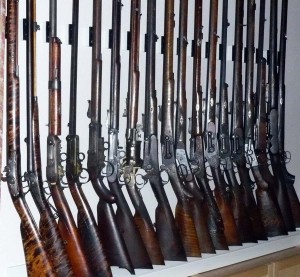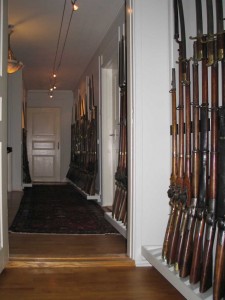My collections
My collections
I really have two collections. The first is the “serious” collection covering small-arms and blades used in the Norwegian Army and Navy from early 1700′s-WW2, much of it described in this site.
The other is “my kitchen collection” of Norwegian or Norwegian used civilian specialities (tennstempel rifles, different patents etc.), locally handcrafted guns and semi-misfits.
I just love getting my hand on something that never should have been made. These should show a serious effort in making the gun, but it does not matter if the parts come from a number of older guns or if it is too complicated to ever have worked properly. The important thing is that it was not from the want of trying and that it was done in Norway! As of now, this part of my collection really consists only of a few long-guns, but there is room for many more….
I also have some really great international “collectors items” in the “kitchen collection” – like a civilian wheel lock rifle from the late 1500′s/early 1600′s, a truly magnificent early flintlock jaeger rifle for about 1700 and an early Winchester 1866; – all of these could go in a swap, however.
The picture shows some of my Larsen long-guns, from an early rifled percussion from the late 1840’s to almost modern bolt actions from the 1870’s & 80’s. There is a chapter on Mr. Larsen and his designes at my Hans Larsen article.
My “dangerous” arms collection
I started collecting in the mid 60’s, but due to children, travelling and workload, my collecting was not very active from the late 70’s to the late 90’s. The collection was locked up by the mid 70’s, and my second wife actually had only seen parts of it before the turn of the century.
Crime rates are regretfully soaring in our remote corner of the World as well and the bulk of the collection is now locked away in a fire proof and steel enforced room where theft is improbable. It is a pity the World is going this way and it was bloody expensive building the room!
Due to political circumstances in the second half of the 1800′s (an undesired union with Sweden), Norway built up one of the worlds most advanced armed forces of that time. The average gun model was produced in “vast quantities” (please remember, we are a very small country), sufficient for arming the whole army and was replaced at intervals of only 10-20 years. This is part of the reason for Norwegian military arms often being in fantastic good condition, as well for the wide availability of experimental models and the variety in the approved models. Norwegian guns from the 1800′s really are great fun! We had repeating arms while the English still were converting Enfield percussions to Sniders.
My main interest since the late 60′s has been small-arms used by the Norwegian military forces. As there still is little risk of Norwegian fakes, the three most important things when obtaining a new gun from my point of view are still condition, condition and condition.
A large collection demands a lot of space. I therefore decided early on that I should not include experimental models in my collection (I had a wonderful M1860 falling block conversion I still miss). I also decided that I only would go for models with fairly significant differences. Most of the infantry muskets from the 1700′s are pretty much alike – I settled for the biggest and the blackest – the M1774.
With a couple of exceptions, I’ve pretty much completed my long-gun collection and most of my purchases and swaps of long-guns now are only to get a model in better condition. I still have great holes in my pistol collection, especially in the Norwegian army’s flintlock pistols, and my collection of edged weapons is virtually non-existing except for bayonets.
About gun collecting in general
Most gun collectors (or collectors of just about anything else, for that matter) start out with a few items they more or less got hold of by chance. Eventually one builds up expertise within the field and starts specializing in one or two lines really of interest.
Here in Norway there are a number of collectors of Norwegian military arms. Hardly any of us have a really great collection, compared to the collectors with extreme specialization. For instance, there are people collecting Norwegian Naval pistols from 1700-1850 who are able to show a line of 20 different fabulously fine pistols in a field where there is no, or next to no, documentation. I’ve seen only three of these pistol models on the market over the almost forty years I have been collecting. This is an extremely impressive collection and due to the fact that it covers 150 years, there is at least some variation between the models.
Other collectors may be specialised in Norwegian kammerladere and have some 40-70 of the different models and variations. There are several specialized kammerlader collectors i Norway. The more you know within a field, the more interesting the field gets. I still find that a kammerlader is more or less just a kammerlader. Stick to the models with major differences, and forget trying to find the complete line – but, admittedly, – I do get impressed!
This applies all over the world. There are not all that many Colt percussion models, but there are a load of people specialising in just this with an enormous variety of different versions – or Mauser C96 pistols or strangely marked K98 or….
Personally, I prefer the collection of a more historical line where one sees the historical, technical, financial and political development of a country or a manufacturer. This kind of collection will hardly ever be as impressive for the “know a good deal” collector as the truly specialised collection, but gives a lot more variation and a lot more excitement, from my point of view.
One important thing – gun collecting takes up space. A lot of guns demands a lot of space. A lot of guns also make a house very tempting to break into and stolen guns on the market make the public very willing to accept banning gun collection altogether. This has more or less happened in Denmark and Sweden. Make sure it is not your fault that it happens where you live.
Gun collecting in Norway and the law
Norway had rather restrictive gun laws in the 60′s and 70′s compared to other countries. These days the restrictive laws Norway then enforced actually seem rather liberal compared to many European countries. Nevertheless, with some items collecting in Norway tends to be very difficult. The details might be somewhat inaccurate, but the following provides a general picture of gun collecting in Norway today:
Rifles and other long-guns older than 1884 are completely unregulated, altered in 2009 to “produced for black powder charge only and before 1890”. You may have as many as you like. The same goes for pistols and revolvers older than 1871, again altered in 2009 “produced for black powder charge before 1890”. You may, however, keep your existing arms produced after 1890 if the model date is as mentioned. You may not acquire new new items produced after 1890. Shotguns were not licensed in Norway until some fifteen years ago, your older shotguns can stay unlicensed, but you need a license for purchasing a new one.
For guns newer than the above mentioned, one needs a license from the police unless “due to design or condition should not be regarded as a firearm”. You’ve heard about the guy selling elastic band by the meter? There has been some discussion in regards to this over the years!
As non-collector one has to “prove” a need for the gun – as a target shooter, hunter or whatever – just about anything except self defense! You’d never get a legal gun for self defence in Norway – no way – only the bad guys should have guns for firing at people! As a non-collector you can have only one gun of each kind and you will have to “prove” a continuous need for every one.
As a collector things are a lot easier, except that you probably never will be allowed to fire your guns… Within your approved field of collection, you can have more or less as many licensed guns as you’d like – when you are approved as a collector, that is. In order to be approved as a collector, you need a membership in Norsk Våpenhistorisk Selskap.
Fully automatic guns are (almost) a great big “NO” in Norway to day – even for serious collectors with specialized collections within the field. There are some possible exceptions, but they are just about purely theoretical in practice.
Storage is getting to be an important issue here in Norway and regulations are being enforced on the public (Interestingly, similar regulations do not apply to the Army, The Army can have unattended depots with fully automatic firearms in the middle of nowhere secured with a padlock – and that is ok).
We, the public have to have all licensed pistols and revolvers locked away in an approved secure arms cabinet. If you have more than 25 licensed guns, you need an approved secure gun room. And, depending on what you have there, you might also have a secure arms cabinet in the gun room as a double safety.
The alarm company I’m hooked up to, guarantees maximum 20 min before they are here if the alarm goes off. Even with the best of tools and knowledge of how the room was built, I doubt anybody can break into my gun room in less than one hour – I believe my collection should be fairly safe.
I’m making a bit of fun of the regulations here, although really I find them to be rather sensible. The silly thing is that ex-Army personnel have ten-thousands of fully automatic rifles in their homes with no regulations for security at all, and that army depots with guns and ammunition are being burgled “all the time”.




